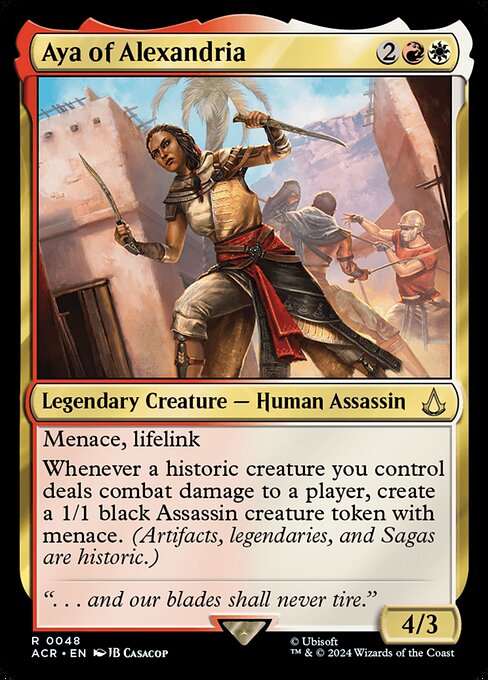
Image courtesy of Scryfall.com
Aya of Alexandria and the playful world of parody cards
Parody cards and crossovers have long served as a cultural heartbeat for Magic: The Gathering fans. They’re not just novelty; they’re a pulse check on how players remix story, history, and humor with strategic depth. Aya of Alexandria—an MTG card that lands squarely at this intersection—offers a vivid case study. Born from the Assassin’s Creed crossover, Aya sports a brisk mana cost of {2}{R}{W}, a red-white identity that mirrors the impulsive bravado and righteous tempo many players love in their aggro builds. This legendary Human Assassin is a rare foil of design nuance, a character who embodies both the daring of a daredevil and the precision of a veteran tactician 🧙♂️🔥.
Her illustration—crafted by JB Casacop—speaks in the language of myth and modern heroism, a fusion that parries with the historical motifs embedded in the crossover. The flavor text, “. . . and our blades shall never tire,” isn’t just a line; it’s a refrain that echoes in many MTG circles when players discuss the staying power of a well-timed attack or a resilient board state. The card’s rarity — rare — and its set designation Assassin’s Creed (acr) place Aya in a unique niche, where collectible value meets cultural conversation 💎⚔️.
What the card does, and why it matters in play
Aya of Alexandria wears two classic MTG textures on her sleeve: Menace and Lifelink. Menace ensures that blocking is a meaningful choice, often forcing players to commit more resources to stop Aya from bleeding through damage. Lifelink adds staying power, turning every swing into a potential swing in your favor as life totals ebb and flow. But the real engine behind Aya’s design is her triggered ability: “Whenever a historic creature you control deals combat damage to a player, create a 1/1 black Assassin creature token with menace.” This is a powerful, tempo-forward reward that scales with your board state, especially as you lean into historic matters—a keyword that includes artifacts, legendaries, and Sagas in MTG’s broader taxonomy.
In practical terms, Aya invites you to assemble a strategy that blends card types into a cohesive historic creature swarm deck. The moment Aya connects with combat and pushes through damage, you’re rewarded with a token army that shares her menace and pairs nicely with lifelink for staying power. It’s a design that rewards aggression while creating a safety net of evasive threats to pressure opponents. Many players at casual tables relish these kinds of swingy lines; they feel cinematic, almost like a chapter from a video game side-quest where every encounter yields loot and momentum 🧙♂️🎲.
Design, lore, and the cross-cultural conversation
Design-wise, Aya is a masterclass in crossover authenticity. The Assassin’s Creed branding isn’t just cosmetic; it’s a deliberate attempt to bridge fan communities—video game buffs, history enthusiasts, and MTG tacticians—into a shared experience. That synergy plays out in how Aya interacts with the historic creature theme: you don’t need a full library of Sagas or artifacts to leverage her. Still, the synergy shines most when you lean into artifacts and legendary creatures that count toward historic, turning a single card into a springboard for a broader engine. It’s a playful reminder that MTG isn’t a vacuum; it’s a cultural hive where ideas from adjacent fandoms can be folded into strategic, elegant game plans 🔥🧭.
The card’s storyline and flavor tie into a broader conversation about the role of parody in game culture. Parody cards keep the game approachable and invite new players to sniff around the edges of the ecosystem they might not otherwise explore. They become talking points at tables, podcasts, and forums, sparking debates about balance, flavor, and the right amount of fan service. Aya’s presence in the Assassin’s Creed set also demonstrates how MTG values licenses that resonate with players’ sense of history and myth—an echo of the way memes and fan art long shape the living culture of the game. It’s amusing to see how a card can function as both a practical toolkit for competitive play and a cultural artifact that signals what MTG fans love about storytelling across media 🧙♂️💎.
From a collector’s perspective, Aya sits at an interesting intersection of art, gameplay, and licensing novelty. The card exists in foil and non-foil forms with prices that reflect not only its play value but its place in a crossover narrative. This is theMTG moments where the line between gaming and memorabilia blurs in the most delightful way, turning battlefield recaps into stories you’ll tell at the kitchen table or online streams ⚔️🎨.
For players looking to experiment with Aya in a real-world build, you might start by pairing her with other historic synergy pieces—artifacts that count toward historic, or legendary creatures that push the threshold of your command zone. The token generation becomes a cascading payoff: each combat phase can spawn additional attackers that maintain pressure while your lifelink keeps you in the game longer than your opponent expects. In practice, Aya invites a tempo-forward, midrange approach that leans into control-leaning curve management while maintaining an aggressive heartbeat. It’s a reminder that cross-promotional designs can still respect the fundamental laws of the game while inviting new twists and joy 🧙♂️💥.
And if you’re curious how this kind of design philosophy translates to broader MTG culture, keep in mind that parody cards are as much about the community as they are about the cards themselves. They invite laughs, debate, and creative deck-building experiments—often spurring new memes that become touchstones for years of play. In that sense, Aya isn’t just a card; she’s a doorway into a conversation about how players read, remix, and reimagine the game they adore 🎲.
Rugged Phone Case with TPU Shell Shock ProtectionMore from our network
- https://crypto-acolytes.xyz/blog/post/minecraft-performance-optimization-practical-tips-for-higher-fps/
- https://transparent-paper.shop/blog/post/lower-ad-costs-without-losing-reach/
- https://transparent-paper.shop/blog/post/how-to-create-prototypes-in-adobe-xd/
- https://transparent-paper.shop/blog/post/how-transparent-digital-overlays-change-interface-design/
- https://blog.zero-static.xyz/blog/post/endless-detour-mastering-enchantment-and-artifact-interactions/